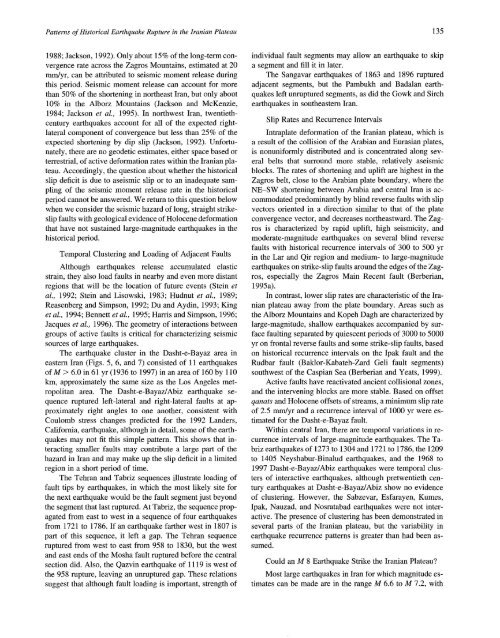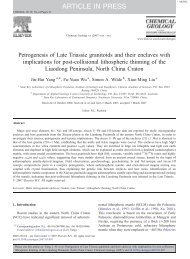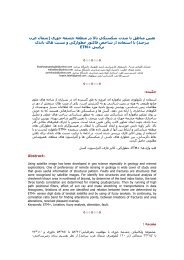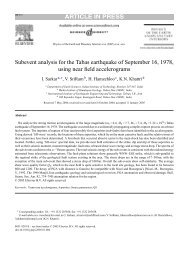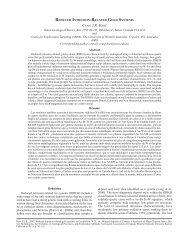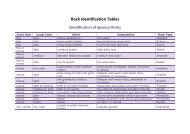Patterns of Historical Earthquake Rupture in the Iranian Plateau
Patterns of Historical Earthquake Rupture in the Iranian Plateau
Patterns of Historical Earthquake Rupture in the Iranian Plateau
- No tags were found...
You also want an ePaper? Increase the reach of your titles
YUMPU automatically turns print PDFs into web optimized ePapers that Google loves.
<strong>Patterns</strong> <strong>of</strong> <strong>Historical</strong> <strong>Earthquake</strong> <strong>Rupture</strong> <strong>in</strong> <strong>the</strong> <strong>Iranian</strong> <strong>Plateau</strong> 1351988; Jackson, 1992). Only about 15% <strong>of</strong> <strong>the</strong> long-term convergencerate across <strong>the</strong> Zagros Mounta<strong>in</strong>s, estimated at 20mm/yr, can be attributed to seismic moment release dur<strong>in</strong>gthis period. Seismic moment release can account for morethan 50% <strong>of</strong> <strong>the</strong> shorten<strong>in</strong>g <strong>in</strong> nor<strong>the</strong>ast Iran, but only about10% <strong>in</strong> <strong>the</strong> Alborz Mounta<strong>in</strong>s (Jackson and McKenzie,1984; Jackson et al., 1995). In northwest Iran, twentiethcenturyearthquakes account for all <strong>of</strong> <strong>the</strong> expected fightlateralcomponent <strong>of</strong> convergence but less than 25% <strong>of</strong> <strong>the</strong>expected shorten<strong>in</strong>g by dip slip (Jackson, 1992). Unfortunately,<strong>the</strong>re are no geodetic estimates, ei<strong>the</strong>r space based orterrestrial, <strong>of</strong> active deformation rates with<strong>in</strong> <strong>the</strong> <strong>Iranian</strong> plateau.Accord<strong>in</strong>gly, <strong>the</strong> question about whe<strong>the</strong>r <strong>the</strong> historicalslip deficit is due to aseismic slip or to an <strong>in</strong>adequate sampl<strong>in</strong>g<strong>of</strong> <strong>the</strong> seismic moment release rate <strong>in</strong> <strong>the</strong> historicalperiod cannot be answered. We return to this question belowwhen we consider <strong>the</strong> seismic hazard <strong>of</strong> long, straight strikeslipfaults with geological evidence <strong>of</strong> Holocene deformationthat have not susta<strong>in</strong>ed large-magnitude earthquakes <strong>in</strong> <strong>the</strong>historical period.Temporal Cluster<strong>in</strong>g and Load<strong>in</strong>g <strong>of</strong> Adjacent FaultsAlthough earthquakes release accumulated elasticstra<strong>in</strong>, <strong>the</strong>y also load faults <strong>in</strong> nearby and even more distantregions that will be <strong>the</strong> location <strong>of</strong> future events (Ste<strong>in</strong> etal., 1992; Ste<strong>in</strong> and Lisowski, 1983; Hudnut et al., 1989;Reasenberg and Simpson, 1992; Du and Ayd<strong>in</strong>, 1993; K<strong>in</strong>get al., 1994; Bennett et al., 1995; Harris and Simpson, 1996;Jacques et al., 1996). The geometry <strong>of</strong> <strong>in</strong>teractions betweengroups <strong>of</strong> active faults is critical for characteriz<strong>in</strong>g seismicsources <strong>of</strong> large earthquakes.The earthquake cluster <strong>in</strong> <strong>the</strong> Dasht-e-Bayaz area <strong>in</strong>eastern Iran (Figs. 5, 6, and 7) consisted <strong>of</strong> 11 earthquakes<strong>of</strong>M > 6.0 <strong>in</strong> 61 yr (1936 to 1997) <strong>in</strong> an area <strong>of</strong> 160 by 110km, approximately <strong>the</strong> same size as <strong>the</strong> Los Angeles metropolitanarea. The Dasht-e-Bayaz/Abiz earthquake sequenceruptured left-lateral and fight-lateral faults at approximatelyfight angles to one ano<strong>the</strong>r, consistent withCoulomb stress changes predicted for <strong>the</strong> 1992 Landers,California, earthquake, although <strong>in</strong> detail, some <strong>of</strong> <strong>the</strong> earthquakesmay not fit this simple pattern. This shows that <strong>in</strong>teract<strong>in</strong>gsmaller faults may contribute a large part <strong>of</strong> <strong>the</strong>hazard <strong>in</strong> Iran and may make up <strong>the</strong> slip deficit <strong>in</strong> a limitedregion <strong>in</strong> a short period <strong>of</strong> time.The Tehran and Tabriz sequences illustrate load<strong>in</strong>g <strong>of</strong>fault tips by earthquakes, <strong>in</strong> which <strong>the</strong> most likely site for<strong>the</strong> next earthquake would be <strong>the</strong> fault segment just beyond<strong>the</strong> segment that last ruptured. At Tabriz, <strong>the</strong> sequence propagatedfrom east to west <strong>in</strong> a sequence <strong>of</strong> four earthquakesfrom 1721 to 1786. If an earthquake far<strong>the</strong>r west <strong>in</strong> 1807 ispart <strong>of</strong> this sequence, it left a gap. The Tehran sequenceruptured from west to east from 958 to 1830, but <strong>the</strong> westand east ends <strong>of</strong> <strong>the</strong> Mosha fault ruptured before <strong>the</strong> centralsection did. Also, <strong>the</strong> Qazv<strong>in</strong> earthquake <strong>of</strong> 1119 is west <strong>of</strong><strong>the</strong> 958 rupture, leav<strong>in</strong>g an unruptured gap. These relationssuggest that although fault load<strong>in</strong>g is important, strength <strong>of</strong><strong>in</strong>dividual fault segments may allow an earthquake to skipa segment and fill it <strong>in</strong> later.The Sangavar earthquakes <strong>of</strong> 1863 and 1896 rupturedadjacent segments, but <strong>the</strong> Pambukh and Badalan earthquakesleft unruptured segments, as did <strong>the</strong> Gowk and Sirchearthquakes <strong>in</strong> sou<strong>the</strong>astern Iran.Slip Rates and Recurrence IntervalsIntraplate deformation <strong>of</strong> <strong>the</strong> <strong>Iranian</strong> plateau, which isa result <strong>of</strong> <strong>the</strong> collision <strong>of</strong> <strong>the</strong> Arabian and Eurasian plates,is nonuniformly distributed and is concentrated along severalbelts that surround more stable, relatively aseismicblocks. The rates <strong>of</strong> shorten<strong>in</strong>g and uplift are highest <strong>in</strong> <strong>the</strong>Zagros belt, close to <strong>the</strong> Arabian plate boundary, where <strong>the</strong>NE-SW shorten<strong>in</strong>g between Arabia and central Iran is accommodatedpredom<strong>in</strong>antly by bl<strong>in</strong>d reverse faults with slipvectors oriented <strong>in</strong> a direction similar to that <strong>of</strong> <strong>the</strong> plateconvergence vector, and decreases nor<strong>the</strong>astward. The Zagrosis characterized by rapid uplift, high seismicity, andmoderate-magnitude earthquakes on several bl<strong>in</strong>d reversefaults with historical recurrence <strong>in</strong>tervals <strong>of</strong> 300 to 500 yr<strong>in</strong> <strong>the</strong> Lar and Qir region and medium- to large-magnitudeearthquakes on strike-slip faults around <strong>the</strong> edges <strong>of</strong> <strong>the</strong> Zagros,especially <strong>the</strong> Zagros Ma<strong>in</strong> Recent fault (Berberian,1995a).In contrast, lower slip rates are characteristic <strong>of</strong> <strong>the</strong> <strong>Iranian</strong>plateau away from <strong>the</strong> plate boundary. Areas such as<strong>the</strong> Alborz Mounta<strong>in</strong>s and Kopeh Dagh are characterized bylarge-magnitude, shallow earthquakes accompanied by surfacefault<strong>in</strong>g separated by quiescent periods <strong>of</strong> 3000 to 5000yr on frontal reverse faults and some strike-slip faults, basedon historical recurrence <strong>in</strong>tervals on <strong>the</strong> Ipak fault and <strong>the</strong>Rudbar fault (Baklor-Kabateh-Zard Geli fault segments)southwest <strong>of</strong> <strong>the</strong> Caspian Sea (Berberian and Yeats, 1999).Active faults have reactivated ancient collisional zones,and <strong>the</strong> <strong>in</strong>terven<strong>in</strong>g blocks are more stable. Based on <strong>of</strong>fsetqanats and Holocene <strong>of</strong>fsets <strong>of</strong> streams, a m<strong>in</strong>imum slip rate<strong>of</strong> 2.5 mm/yr and a recurrence <strong>in</strong>terval <strong>of</strong> 1000 yr were estimatedfor <strong>the</strong> Dasht-e-Bayaz fault.With<strong>in</strong> central Iran, <strong>the</strong>re are temporal variations <strong>in</strong> recurrence<strong>in</strong>tervals <strong>of</strong> large-magnitude earthquakes. The Tabrizearthquakes <strong>of</strong> 1273 to 1304 and 1721 to 1786, <strong>the</strong> 1209to 1405 Neyshabur-B<strong>in</strong>alud earthquakes, and <strong>the</strong> 1968 to1997 Dasht-e-Bayaz/Abiz earthquakes were temporal clusters<strong>of</strong> <strong>in</strong>teractive earthquakes, although pretwentieth centuryearthquakes at Dasht-e-Bayaz/Abiz show no evidence<strong>of</strong> cluster<strong>in</strong>g. However, <strong>the</strong> Sabzevar, Esfarayen, Kumes,Ipak, Nauzad, and Nosratabad earthquakes were not <strong>in</strong>teractive.The presence <strong>of</strong> cluster<strong>in</strong>g has been demonstrated <strong>in</strong>several parts <strong>of</strong> <strong>the</strong> <strong>Iranian</strong> plateau, but <strong>the</strong> variability <strong>in</strong>earthquake recurrence patterns is greater than had been assumed.Could an M 8 <strong>Earthquake</strong> Strike <strong>the</strong> <strong>Iranian</strong> <strong>Plateau</strong>?Most large earthquakes <strong>in</strong> Iran for which magnitude estimatescan be made are <strong>in</strong> <strong>the</strong> range M 6.6 to M 7.2, with


